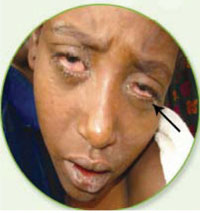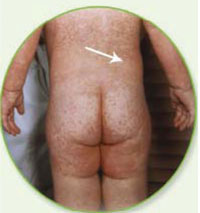4.2.3 Clinical manifestations of measles
The first sign of infection with measles is a high fever, which begins approximately 10–12 days after exposure to the virus and lasts for several days. During this period, the child may develop a runny nose, a cough, red and watery eyes (Figure 4.2), and small white spots inside his or her cheeks.

Conjunctivitis is pronounced 'con-junk-tiv-eye-tiss'.
After several days, a slightly raised rash (appearance of small pigmentations or red spots on the skin, or ‘shifta’ in Amharic), develops, usually on the face and upper neck. Over a period of about three days, the rash spreads to the body (Figure 4.3) and then to the hands and feet. It lasts for five or six days and then gradually fades. The incubation period from exposure to the onset of the rash averages 14 days.

To identify cases of measles, you need to confirm the presence of fever and rash, with cough or running nose, or conjunctivitis (red eyes).
Measles may be severe, causing several complications that can lead to permanent disability or death, including pneumonia (infection of the lower respiratory tract), encephalitis (infection in the brain), otitis media (infection of the middle ear), corneal clouding and blindness (Figure 4.4), and diarrhoea with dehydration. You will learn about pneumonia and acute otitis media in more detail in Study Session 35.

The structure of the eye and the main causes of blindness are covered in the Module on Non-Communicable Diseases, Emergency Care and Mental Health.
Severe measles, manifested by complications such as pneumonia, and clouding of the eyes or blindness, is particularly likely in poorly nourished children, especially those who do not receive sufficient vitamin A in their diet. Vitamin A, which is found in yellow vegetables like carrots and yellow fruits like mangoes, is essential for good eyesight and it also strengthens the immune system of children. If measles develops in a child with a shortage of vitamin A, this makes the disease more severe and damage to eyesight is more likely. Measles and vitamin A deficiency together are a major cause of blindness among children in Africa and in other areas of the world where measles is common. Children who live in crowded conditions and whose immune systems have been weakened by HIV/AIDS, or other diseases, are also more likely to develop severe measles.
Give a reason why malnourished children are more likely to develop severe measles.
Children with malnutrition, particularly those who lack vitamin A, have weak immunity and cannot fight the measles virus, which causes severe clinical symptoms and may even kill them.
4.2.2 Mode of transmission of measles
